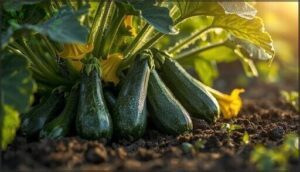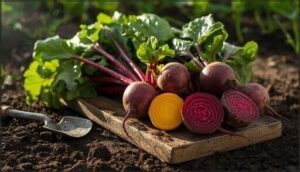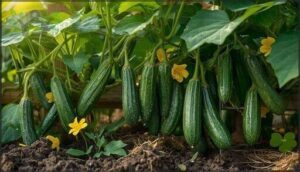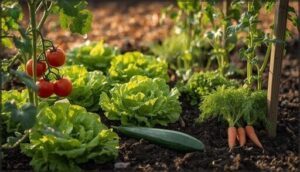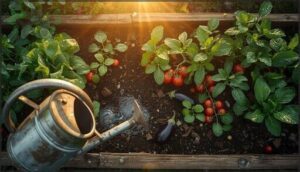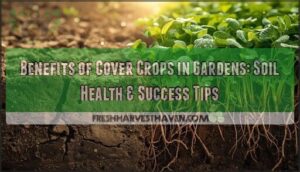This site is supported by our readers. We may earn a commission, at no cost to you, if you purchase through links.
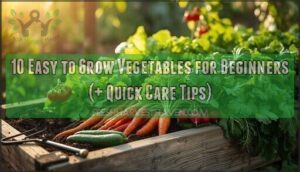
These aren’t rare gardening victories reserved for experts—they’re typical results when you match the right vegetables to your conditions. The secret lies in choosing crops that forgive rookie mistakes, tolerate less-than-perfect soil, and mature quickly enough to keep you motivated.
Whether you’re working with a backyard plot or a few containers on a balcony, certain vegetables practically grow themselves once you understand their basic needs.
Table Of Contents
- Key Takeaways
- Top 10 Easiest Vegetables to Grow
- Fast-Growing Vegetables for Quick Harvests
- Low-Maintenance Vegetables for Beginners
- Soil, Sunlight, and Watering Essentials
- Gardening Tips for a Successful Harvest
- Frequently Asked Questions (FAQs)
- What vegetables are easy to grow for a beginner gardener?
- Are vegetables easy to grow?
- How do you grow a vegetable garden?
- How do I choose the best vegetables for my Garden?
- What vegetables grow fast?
- What vegetables can you grow in a container garden?
- What is the easiest vegetable to grow?
- What is the best garden for a beginner?
- What is the lowest maintenance crop?
- What vegetable grows in 30 days?
- Conclusion
Key Takeaways
- Start with beginner-friendly vegetables like radishes (22-30 days), leaf lettuce (30 days), and green beans (50-62 days) that forgive mistakes and mature quickly enough to keep you motivated through early growing seasons.
- Match your vegetable choices to your specific conditions—cool-season crops like spinach and peas thrive in spring and fall temperatures between 50-70°F, while warm-weather plants like tomatoes and zucchini need 6-8 hours of direct sunlight and well-drained soil with pH 6.0-7.0.
- Success depends more on consistent watering (1-2 inches weekly through deep, infrequent irrigation) and proper soil preparation (loamy texture with 2% organic matter) than on advanced gardening knowledge or experience.
- Container gardening works perfectly for small spaces like balconies, with compact varieties of lettuce, spinach, and radishes producing substantial yields while companion planting with marigolds and nasturtiums naturally controls pests without chemicals.
Top 10 Easiest Vegetables to Grow
If you’re new to gardening, you’ll want to start with vegetables that practically grow themselves. The best beginner crops forgive mistakes, mature quickly, and reward you with plenty of food for your efforts.
Here are ten vegetables that’ll help you build confidence while you’re learning the ropes.
Lettuce
Lettuce tops the list for beginner gardeners, especially leaf lettuce varieties that mature in just 30 days. You’ll want soil temperatures around 40°F to start, aiming for that sweet spot of 60–65°F during growth.
Plant early to prevent bolting in warmer weather, and keep soil consistently moist with daily watering once temperatures climb above 75°F. Both head lettuce and hydroponic lettuce thrive with proper care.
For best results, use a nitrogen-based fertilizer about 4 weeks after transplanting.
Radishes
Radishes rank among the easiest vegetables for beginner gardeners, maturing in just 22–30 days. Plant seeds at 0.25-inch planting depth in sandy, well-drained soil with pH above 5.5. Space them 1 inch apart for best growth. Different radish varieties offer varying harvest timing—standard types reach maturity quickly while Chinese varieties take 50–90 days.
They thrive best as a cool season crop for best growth in spring and autumn.
Beyond their speed, you’ll appreciate their nutritional value: just 19 calories per cup with solid vitamin C content.
Green Beans
Green beans stand out among easy vegetables for beginner gardeners, with bush varieties requiring minimal support and yielding 0.5 pounds per plant in 50–62 days. Plant them in slightly acidic soil (pH 6.5) with six to eight hours of sunlight daily.
Their pest resistance and nutritional benefits—34 calories per cup with 3.74 grams of fiber—make them ideal for beginner gardeners seeking yield optimization and straightforward harvesting tips.
Tomatoes
You’ll find tomatoes among the most rewarding easy vegetables for beginners, with each plant producing 10–15 pounds of fruit given proper conditions. Choose disease-resistant tomato varieties and provide at least six hours of direct sunlight daily.
Container size matters—use 18-inch pots for determinate types and 24-inch for indeterminate. Water consistently to prevent blossom end rot, and you’ll master vegetable gardening for beginners quickly.
Zucchini
Your vegetable garden won’t find a more productive beginner-friendly crop than zucchini. Each plant delivers 18–35 fruits per season when you provide full sun (6–8 hours daily), well-drained soil with a pH between 6.0 and 7.5, and consistent deep watering 2–3 times weekly.
Watch for squash bugs and powdery mildew, but don’t worry—zucchini’s impressive yield forgives most growing mistakes beginner gardeners make.
Peas
Among easy-to-grow vegetables for beginner gardeners, peas reward your early spring efforts with sweet pods in just 50–60 days. These cool-season stars thrive when you:
- Plant seeds ½–1 inch deep in soil above 40°F, spacing rows 12–24 inches apart
- Choose pea varieties suited to your climate—snow, snap, or shelling types
- Water consistently during flowering for maximum pod production
- Practice pest control through companion planting to deter aphids
Your vegetable garden benefits nutritionally too—each serving delivers substantial protein, fiber, and vitamins.
Carrots
Carrots earn their place in beginner gardeners’ vegetable gardens thanks to forgiving growing conditions. You’ll need loose, stone-free soil about 12 inches deep—sandy loam works best—with a pH between 6.0 and 6.8.
Plant carrot varieties in full sun, water consistently (about ¾ inch every five days), and thin seedlings early for proper root development.
Harvest your sweet rewards in 60–80 days.
Spinach
Spinach varieties thrive when you plant them in nutrient-rich soil between 50°F and 60°F—perfect for cool spring and fall gardens.
Keep these leafy greens happy with:
- Water consistently to maintain 60–75% soil moisture and prevent bolting
- Space seedlings 3 inches apart in rows 12 inches wide
- Harvest outer leaves after 37–55 days for continuous growth
You’ll enjoy fresh spinach while mastering soil conditions that benefit other beginner vegetables.
Beets
You can’t beat beets for beginner-friendly vegetable gardening—these root vegetables handle various soil conditions and deliver both nutritious roots and greens.
| Growing Aspect | Requirement | Timeline |
|---|---|---|
| Soil pH | 6.0–7.0 | — |
| Temperature | 50°F–70°F | — |
| Spacing | 3–4 inches | — |
| Harvest | Root & greens | 50–70 days |
Plant beet varieties like disease-resistant ‘Touchstone Gold’ in well-drained loamy soil. Thin seedlings to nine plants per square foot, water consistently, and enjoy their high fiber and folate content.
Cucumbers
Cucumbers thrive in warm weather and reward beginner gardeners with abundant harvests—expect 20–25 pounds per plant when you get conditions right.
Choose slicing or pickling cucumber varieties, then provide 6–8 hours of direct sunlight and well-drained soil with a pH of 6.0–7.0.
Water deeply once or twice weekly, watch for cucumber beetles through May and June, and start harvesting your vegetable garden’s fresh cucumbers within 50–70 days.
Fast-Growing Vegetables for Quick Harvests
If you’re keen to see results fast, some vegetables are ready to harvest in less than two months—perfect for building your confidence early in the season. These quick growers let you enjoy fresh produce while your slower crops are still maturing.
Let’s look at a few favorites that go from seed to table in no time.
Radishes (22–30 Days)
When you’re keen to see your garden pay off fast, radishes deliver. These easy-to-grow crops reach harvest size in just 22 to 30 days, making them ideal for beginner gardeners seeking quick wins. Plant them in cool weather to prevent bolting, and you’ll soon enjoy crisp, peppery roots packed with vitamin C and potassium.
Quick tips for harvesting radishes:
- Choose fast radish varieties – Spring types mature fastest for intercropping radishes between slower plants
- Plant early – Sow as soon as soil is workable in spring
- Space seeds 2.5 cm apart – Proper spacing prevents crowding and disease
- Water consistently – Keeps roots tender and prevents cracking
- Harvest promptly – Pull when roots reach full size to maintain crisp texture and radish nutrition
Leaf Lettuce (30 Days)
Leaf lettuce reaches harvest size in roughly 30 days, making it one of the easiest vegetables for beginner gardeners to grow. You’ll find lettuce varieties suited to nearly any garden setup—soil beds or hydroponic systems both work well.
Plant early in spring for bolting prevention, maintain consistent moisture, and you’ll enjoy fresh, nutrient-rich greens packed with vitamins A and K before most other vegetables mature.
Peas (50–60 Days)
Peas mature in 50–60 days, thriving in cool weather that other vegetables can’t handle. Sow them early when soil temperatures hit 50°F, and you’ll harvest pods by early summer.
- Plant in loose, well-drained soil with pH 5.5–7.0
- Provide at least six hours of direct sunlight daily
- Water consistently—about 1 inch per week
- Use trellis support for climbing pea varieties
- Pick pods regularly to encourage continued production
These nitrogen-fixing plants actually improve your garden’s soil for future crops.
Zucchini and Summer Squash (45–60 Days)
Want an even faster producer? Zucchini and summer squash deliver edible fruits in just 45–60 days. Each plant churns out 6 to 10 pounds per season—sometimes more than you can eat!
Plant them in full sun with well-drained soil (pH 6.0–7.2), and harvest every 2–3 days once they start.
These easy-to-grow crops are perfect for beginner gardeners craving quick wins and plenty of recipe ideas.
Low-Maintenance Vegetables for Beginners
If you’re new to gardening, you’ll want vegetables that don’t demand constant attention or fussy care routines. The best beginner options are those that forgive minor mistakes, tolerate less-than-perfect conditions, and still reward you with a solid harvest.
For new gardeners, the best vegetables are the ones that forgive mistakes, tolerate imperfect conditions, and still deliver a solid harvest
Let’s look at four reliable, low-maintenance vegetables that practically grow themselves.
Green Beans and Bush Beans
Green beans and bush green beans rank among the easiest-to-grow crops for beginner gardeners. These bean varieties mature in 50–62 days and naturally improve soil through nitrogen fixation. They prefer a pH of 6.0–7.0 and thrive with minimal fussing.
Disease resistance varies by cultivar, so choose wisely.
Harvesting tips: Pick pods when firm and snap easily for best flavor and continued production throughout the season.
Lettuce and Leafy Greens
Lettuce varieties and leafy greens thrive with minimal effort, making them ideal easy-to-grow crops for beginner gardeners. These cool-season plants prefer temperatures between 65–70°F and need about 1 inch of water weekly. Most lettuce matures in 41–95 days, depending on type.
Growing conditions include light, loamy soil with a pH of 6.0–6.5.
Harvesting tips: Pick outer leaves first to encourage continued production throughout your garden care season.
Beets and Root Vegetables
Root vegetables like beets, carrots, and radishes offer beginner gardeners a low-fuss path to harvest success. Beets grow best in loamy soil with a neutral pH and mature in 8–10 weeks, while carrots need loose ground to prevent deformed roots.
Quick Care Essentials:
- Soil preparation: Loosen soil 12+ inches deep to prevent compaction
- Planting density: Space beets 9–16 per square foot
- Harvesting tips: Pull beets at 3 inches in diameter for best flavor
- Disease resistance: Rotate crops yearly to minimize soilborne issues
- Beet nutrition: Rich in fiber, folate, and antioxidants
Spinach and Other Cool-Season Crops
Spinach and other cool-season crops thrive when temperatures dip, making them perfect for early spring or fall planting. You’ll appreciate how spinach tolerates frost while delivering impressive nutritional benefits—high in vitamins A, K, and folate. Bolting prevention matters most: plant 4–8 weeks before your last frost and choose disease-resistant varieties for reliable yields.
Leafy greens like lettuce and radishes share this winter hardiness, requiring consistent irrigation needs but minimal fuss otherwise.
Soil, Sunlight, and Watering Essentials
Getting the basics right makes all the difference between a thriving garden and a frustrating one. You don’t need to be a soil scientist or memorize complex charts—just understanding a few key principles will set you up for success.
Let’s break down what your vegetables actually need to grow strong and productive.
Best Soil Types for Easy Vegetables
Your vegetables will thrive when you start with loamy or sandy loam soil—the sweet spot for drainage and fertility. Aim for a soil pH between 5.5 and 7.0, slightly acidic to neutral, which keeps nutrients available without toxicity risks.
Build up organic matter to at least 2% through compost or manure, improving water retention and aggregate stability. Well-drained soil with good texture sets the foundation for success.
Sunlight Needs by Vegetable Type
Understanding sunlight requirements helps beginner gardeners match vegetable varieties to their garden’s light conditions and improve success. Full sun crops like tomatoes and cucumbers need six to eight hours of direct exposure daily, while partial sun veggies—carrots, beets, and spinach—thrive with four to six hours.
Consider these essentials:
- Fruiting vegetables demand the most light for productivity
- Root crops tolerate some shade with reduced yields
- Leafy greens adapt well to filtered or morning sun
- Seasonal sunlight needs vary by climate and temperature
Watering Tips for Consistent Growth
Getting your watering techniques right builds on smart sun placement. Most beginner gardeners benefit from a watering schedule that delivers one to two inches weekly, keeping soil moisture stable.
Deep, infrequent irrigation beats shallow daily sprinkling—it encourages stronger roots.
Mulch benefits include cutting evaporation by nearly half, so you’ll water less often while your garden care improves.
Drip irrigation methods work best for consistent watering without disease risk.
Fertilizer and PH Considerations
Once you’re watering well, soil preparation techniques and nutrient uptake become your next priorities. Most vegetables thrive between pH 6.0 and 7.5—that ideal pH sweet spot where roots absorb phosphorus and calcium efficiently.
- Acidic soil below 5.5 limits phosphorus availability
- Well-drained soil with compost naturally stabilizes pH near 6.5
- Organic impacts include 20% higher vitamin levels in leafy greens
- Synthetic risks emerge from nitrate buildup in overfertilized plots
- Soil conditioning with aged manure gently adjusts acidity while enriching nutrients
Test your soil, then choose balanced fertilizer thoughtfully.
Gardening Tips for a Successful Harvest
Growing vegetables is one thing—harvesting a successful crop is another. Small adjustments to your approach can make the difference between a disappointing yield and baskets full of fresh produce.
Here are five practical tips to help you avoid common pitfalls and get the most from your garden.
Companion Planting for Pest Control
When you pair certain plants together, you’re creating beneficial insect habitats that tackle garden pests naturally. Marigolds, nasturtiums, and basil work as pest disruption specialists, masking scent cues while attracting helpful predators.
For beginner gardeners growing easy vegetables to grow, companion planting improves yield outcomes, soil health, and disease resistance—reducing your need for chemicals while boosting pest control effectiveness by up to 32%.
Extending The Growing Season
You can stretch your harvest window by weeks—even months—with a few smart techniques. Row covers and cold frames shield cool-season crops from early frosts, while mulching stabilizes soil temperature for late carrots and beets.
Greenhouses push boundaries further, supporting year-round growth in many climates. Succession planting fast-maturing vegetables like radishes ensures continuous yields.
Shade cloth protects warm-season crops during peak summer heat, bridging gaps between your spring and fall frost dates.
Container Gardening for Small Spaces
Even a balcony or patio can become a productive garden when you choose compact varieties. Container gardening for beginners works beautifully with lettuce, spinach, and radishes—all low-maintenance vegetables thriving in pots.
Vertical gardening maximizes space optimization on rooftop gardens, while self-watering containers simplify care.
Select easy-to-grow vegetables suited to your light conditions, and you’ll harvest fresh produce without needing traditional garden beds.
Common Beginner Mistakes to Avoid
Most beginner gardening mistakes stem from overwatering issues and sunlight misjudgments—both of which reduce yields by 30% or more. You’ll also want to avoid soil imbalances, poor planting timing, and fertilizer misuse.
These vegetable gardening for beginners pitfalls are easily preventable with a few beginner gardening tips: water in the morning, test your soil, follow regional frost dates, and fertilize sparingly.
Harvesting and Enjoying Your Vegetables
Harvesting at peak ripeness locks in nutrients and flavor—lettuce before bolting, radishes within 30 days, zucchini at 6–8 inches. Cool-morning harvests extend freshness by days. Proper storage methods and immediate cooling preserve quality for weeks.
Beyond nutritional value, you’ll enjoy real economic benefits—home gardens average $677 in produce yearly. These health benefits and harvesting tips transform your effort into delicious, cost-saving meals.
- Pick vegetables during cool morning hours for maximum freshness
- Store immediately at recommended temperatures to retain nutrients
- Harvest leafy greens before flowering to preserve flavor
- Use proper post-harvest handling to extend shelf life
Frequently Asked Questions (FAQs)
What vegetables are easy to grow for a beginner gardener?
You’d think gardening success requires a green thumb, but it doesn’t. For beginners, choosing easy-to-grow vegetables is key. Lettuce, radishes, and green beans top the list—they’re forgiving, space-efficient, and perfect for organic gardening basics.
Are vegetables easy to grow?
Growing vegetables can feel like a mystery at first, but beginner-friendly crops like radishes and lettuce prove otherwise.
Your vegetable garden doesn’t demand expertise—just patience and a willingness to learn from common growing myths.
How do you grow a vegetable garden?
You’ll be amazed how straightforward vegetable garden success can be.
Start with garden planning, solid soil preparation, and proper sunlight requirements.
Master your watering schedule, learn basic pest control, and watch your harvest flourish.
How do I choose the best vegetables for my Garden?
Start by considering your climate considerations and garden size. Personal preferences matter too—plant what you’ll actually eat.
Space constraints and time commitment help narrow down vegetable selection that fits your lifestyle perfectly.
What vegetables grow fast?
Want a harvest in record time? Radishes top the list for beginners, maturing in just 22–30 days under ideal conditions.
Leaf lettuce follows close behind at 30 days, while arugula matches that speed perfectly.
What vegetables can you grow in a container garden?
You can grow lettuce, spinach, radishes, green beans, and tomatoes in containers. Choose compact or dwarf varieties for space optimization.
Container gardening works perfectly for balcony gardens, letting urban gardening beginners enjoy fresh vegetables anywhere.
What is the easiest vegetable to grow?
Lettuce ranks as the easiest vegetable for beginners. It grows quickly in loose soil, tolerates partial shade, and resists common diseases.
You’ll harvest crisp greens in just 30 days with minimal effort.
What is the best garden for a beginner?
For beginners, gardening for beginners means a small raised bed or container garden offers budget-friendly gardens with controlled soil, excellent drainage, and flexibility.
Choose a sunny spot, plant low-maintenance vegetables, and start simple with easy-to-grow vegetables for success.
What is the lowest maintenance crop?
Beans rank among the lowest-maintenance vegetables you can plant. They thrive in poor soils, resist common diseases, need minimal watering once established, and naturally fix nitrogen—reducing your fertilizer needs considerably.
What vegetable grows in 30 days?
Several fast-growing options reach harvest time within 30 days. Radishes lead with radish varieties maturing in 22-30 days, followed by leaf lettuce, spinach cultivars, and arugula—perfect for extending your growing season with multiple plantings.
Conclusion
You could practically toss seeds in the ground blindfolded and still harvest dinner with these easy to grow vegetables. That’s an exaggeration, but not by much—radishes, lettuce, and green beans genuinely forgive most beginner mistakes.
The difference between a struggling garden and a thriving one often comes down to matching crops to your conditions and staying consistent with water. Start small, pick three vegetables from this list, and you’ll be eating homegrown food within weeks.
- https://provenwinnersdirect.com/blogs/edible-resources/easiest-vegetables-to-grow
- https://themicrogardener.com/17-fast-growing-vegetables-for-impatient-gardeners/
- https://www.gardentech.com/blog/gardening-and-healthy-living/8-easy-to-grow-fruits-and-veggies
- https://journeywithjill.net/gardening/2024/04/11/best-and-worst-crops-for-beginners/
- https://savanagarden.com/blogs/raised-beds-gardening-blog/seven-cool-season-veggies-with-no-pest-issues




